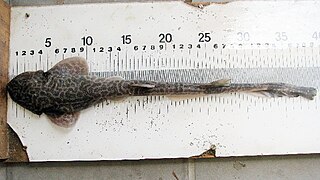 W
WThe Izak catshark or simply Izak is a species of catshark, belonging to the family Scyliorhinidae, common off the coasts of South Africa and southern Namibia. It typically inhabits the outer continental shelf at depths of 100–300 m (330–980 ft), with the males found deeper than the females and juveniles. The Izak catshark has a short, wide, flattened head and a robust body tapering to a long, slender tail. It can be identified by its ornate color pattern of dark brown spots or reticulations and blotches on a light yellowish background, as well as by the enlarged dermal denticles over its pectoral fins and along its dorsal midline from the snout to the second dorsal fin. This species reaches 69 cm (27 in) in length, with the males larger than females.
 W
WThe lined catshark or banded catshark is a species of catshark, belonging to the family Scyliorhinidae. It is found in the waters off the coasts of Beira, Mozambique, to East London, and South Africa between latitudes 19°S and 31°S, from the surface to 290 m. It can grow up to 56 cm in length.
 W
WThe smallbelly catshark is a catshark of the family Scyliorhinidae found in the western Indian Ocean near Somalia, the Gulf of Aden, and Oman, at depths between 1,300 and 1,840 m. Its length is up to 34 cm, although this measurement is of an immature specimen. The smallbelly catshark is not well known. It is found on continental slopes, and is probably caught by bottom trawlers. The reproduction of the smallbelly catshark is oviparous.
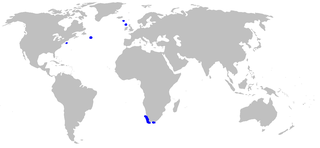 W
WThe smalleye catshark is a catshark of the family Scyliorhinidae, found in the southeast Atlantic at depths between 700 and 2,000 m. It can grow up to 61 cm. The reproduction of this catshark is oviparous.
 W
WThe tiger catshark is a species of catshark, belonging to the family Scyliorhinidae. It is found over sandy areas and near reef peripheries off South Africa and perhaps Mozambique, from close to shore to usually no deeper than 100 m (330 ft). Reaching a length of 50 cm (20 in), this small, slim shark has a broad, flattened head with an upturned snout tip. It can additionally be identified by its dorsal colour pattern of ten dark brown saddles on a yellowish brown background.
 W
WThe yellowspotted catshark is a rare catshark of the family Scyliorhinidae. It is found in the southeast Atlantic, from Lüderitz, Namibia to central Natal, South Africa, between latitudes 0° and 37° S. It can grow up to a length of about 1.22 metres. The reproduction of this catshark is oviparous.
 W
WThe arrowhead dogfish is a small little known deepwater dogfish of the family Centrophoridae.
 W
WThe longsnout dogfish is a little-known deepwater dogfish, found in the Atlantic and Indian Oceans from Namibia to Mozambique and in the South Pacific off southern Australia and New Zealand.
 W
WThe dusky dolphin is a dolphin found in coastal waters in the Southern Hemisphere. Its specific epithet is Latin for "dark" or "dim". It is very closely genetically related to the Pacific white-sided dolphin, but current scientific consensus holds they are distinct species. The dolphin's range is patchy, with major populations around South America, southwestern Africa, New Zealand, and various oceanic islands, with some sightings around southern Australia and Tasmania. The dusky dolphin prefers cool currents and inshore waters, but can also be found offshore. It feeds on a variety of fish and squid species and has flexible hunting tactics. The dusky dolphin is known for its remarkable acrobatics, having a number of aerial behaviours. The status of the dolphin is unknown, but it has been commonly caught in gill nets.
 W
WHeaviside's dolphin, is one of four dolphins in the genus Cephalorhynchus. The small cetacean is endemic to the Benguela ecosystem along the southwest coast of Africa.
 W
WThe lesser guitarfish or lesser sandshark is a species of fish in the Rhinobatidae family. It is found in Angola, Namibia, South Africa, and possibly Mozambique. Its natural habitats are shallow seas and estuarine waters. It is threatened by habitat loss.
 W
WThe Cape gurnard is a species of sea robin native to the Western Indian Ocean where they occur at depths of from 10–390 metres (33–1,280 ft) and in such countries as Mozambique and Namibia. The species is 75 centimetres (30 in) TL in length and lives maximum to the age of 16. This species is of commercial importance as a food fish.
 W
WThe sixgill hagfish or snotslang is a species of marine fish in the hagfish family of order Myxiniformes. It is native to the South Atlantic Ocean and southwestern Indian Ocean.
 W
WThe leerfish or garrick is a species of marine fish in the family Carangidae, and is native to the Mediterranean and the coastal waters of western Africa to the coastal waters of eastern South Africa. Also recorded in the Black Sea. These fish can reach 1.5 m in length and more than 30 kg in weight. They inhabit the coastal wave zone where they form small shoals to hunt other smaller fish, favouring mullets.
 W
WThe Cape horse mackerel is a mackerel-like species in the family Carangidae. It is a pelagic species of the south eastern Atlantic Ocean which is a target of fisheries, mainly as bycatch.
 W
WPterois mombasae, the African lionfish, deepwater firefish or frillfin turkeyfish, is a fish found in the tropical Indian Ocean and the Western Pacific, typically in soft-bottomed areas of the ocean, often in conjunction with invertebrate growth. It grows to a maximum size of 20 cm, and is of moderate commercial value.
 W
WThe onefin electric ray or Cape numbfish is a common but little-known species of electric ray in the family Narkidae, native to South Africa and Namibia. It is a benthic fish found in shallow coastal bays over sandy or muddy bottoms. This small species reaches 38 cm (15 in) in length, and has a nearly circular pectoral fin disc and a short, muscular tail that supports a large caudal fin. It can be identified by its single dorsal fin, which is located over the large pelvic fins. Its dorsal coloration is yellowish to dusky brown.
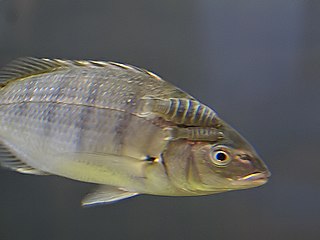 W
WThe west coast seabream or west coast steenbras is a species of marine fish in the family Sparidae. It is found in very shallow water off the coasts of to Angola, Namibia and South Africa. The International Union for Conservation of Nature lists its conservation status as being "near threatened".
 W
WThe zebra sea bream is a species of seabream belonging to the family Sparidae.
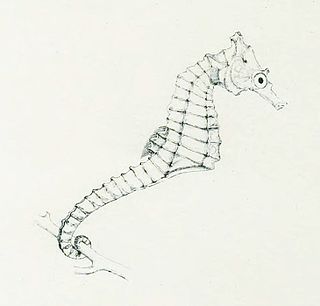 W
WThe giraffe seahorse is a species of fish of the family Syngnathidae. It is found in coastal waters off of the south and east coasts of Africa, from South Africa to Tanzania, and possibly north to Kenya. It lives in estuarine seagrass beds, algae beds, and shallow reefs to depths of 45 metres (148 ft), where it can grow to lengths of 10 centimetres (3.9 in). It is expected to feed on small crustaceans, similar to other seahorses. This species is ovoviviparous, with males carrying eggs in a brood pouch before giving birth to live young. Individuals are sexually mature at around 6.5 centimetres (2.6 in). Major threats to this species could be habitat loss, through coastal development and pollution, and overexploitation through bycatch. Some other threats include human use by drying out the seahorse for traditional medicine or as a curio.
 W
WThe bramble shark is one of the two species of sharks in the family Echinorhinidae. Aside from the eastern Pacific Ocean, it is found in tropical and temperate waters worldwide. This rarely encountered shark swims close to the bottom of the seafloor, typically at depths of 400–900 m (1,300–3,000 ft), though it may enter much shallower water. The bramble shark has a stout body with two small dorsal fins positioned far back and no anal fin. It can be readily identified by the large, thorn-like dermal denticles scattered over its body, some of which may be fused together. It is purplish brown or black in color and grows up to 3.1 m (10 ft) long.
 W
WThe copper shark, bronze whaler, or narrowtooth shark, is a species of requiem shark, family Carcharhinidae, and the only member of its genus found mostly at temperate latitudes. It is distributed in a number of separate populations in the northeastern and southwestern Atlantic, off southern Africa, in the northwestern and eastern Pacific, and around Australia and New Zealand, with scattered reports from equatorial regions. This species can be found from brackish rivers and estuaries, to shallow bays and harbors, to offshore waters 100 m (330 ft) deep or more. Females are found apart from males for most of the year, and conduct seasonal migrations. A large species reaching 3.3 m (11 ft) long, the copper shark is difficult to distinguish from other large requiem sharks. It is characterized by its narrow, hook-shaped upper teeth, lack of a prominent ridge between the dorsal fins, and plain bronze coloration.
 W
WThe goblin shark is a rare species of deep-sea shark. Sometimes called a "living fossil", it is the only extant representative of the family Mitsukurinidae, a lineage some 125 million years old. This pink-skinned animal has a distinctive profile with an elongated, flat snout, and highly protrusible jaws containing prominent nail-like teeth. It is usually between 3 and 4 m long when mature, though it can grow considerably larger such as one captured in 2000 that is thought to have measured 20 ft. Goblin sharks are benthopelagic creatures that inhabit upper continental slopes, submarine canyons, and seamounts throughout the world at depths greater than 100 m (330 ft), with adults found deeper than juveniles. Some researchers believe that these sharks could also dive to depths of up to 1300 m for short periods of time.
 W
WThe smallfin gulper shark is a medium-sized deepwater dogfish in the family Centrophoridae.
 W
WThe school shark is a houndshark of the family Triakidae, and the only member of the genus Galeorhinus. Common names also include tope shark, snapper shark, and soupfin shark. It is found worldwide in temperate seas at depths down to about 800 m (2,600 ft). It can grow to nearly 2 m long. It feeds both in midwater and near the seabed, and its reproduction is ovoviviparous. This shark is caught in fisheries for its flesh, its fins, and its liver, which has a very high vitamin A content. The IUCN has classified this species as critically endangered in its Red List of Threatened Species.
 W
WThe broadnose sevengill shark is the only extant member of the genus Notorynchus, in the family Hexanchidae. It is recognizable because of its seven gill slits, while most shark species have five gill slits, with the exception of the members of the order Hexanchiformes and the sixgill sawshark. This shark has a large, thick body, with a broad head and blunt snout. The top jaw has jagged, cusped teeth and the bottom jaw has comb-shaped teeth. Its single dorsal fin is set far back along the spine towards the caudal fin, and is behind the pelvic fins. In this shark the upper caudal fin is much longer than the lower, and is slightly notched near the tip. Like many sharks, this sevengill is counter-shaded. Its dorsal surface is silver-gray to brown in order to blend with the dark water and substrate when viewed from above. In counter to this, its ventral surface is very pale, blending with the sunlit water when viewed from below. The body and fins are covered in a scattering of small black & white spots. In juveniles, their fins often have white margins.
 W
WThe slimeskate is a species of fish in the family Rajidae. It is found on soft bottoms of the outer shelf and upper slope on the coast of South Africa and Namibia.
 W
WThe whitespotted smooth-hound is a houndshark of the family Triakidae. It is found on the continental shelves of the southeast Atlantic from Namibia around South Africa, between latitudes 17° S and 36° S, from the surface to a depth of 440 m. It can reach a length of 1.2 m. The reproduction of this houndshark is Ovoviviparous.
 W
WThe short-tail stingray or smooth stingray is a common species of stingray in the family Dasyatidae. It occurs off southern Africa, typically offshore at a depth of 180–480 m (590–1,570 ft), and off southern Australia and New Zealand, from the intertidal zone to a depth of 156 m (512 ft). It is mostly bottom-dwelling in nature and can be found across a range of habitats from estuaries to reefs, but also frequently will swim into open water. The largest stingray in the world, this heavy-bodied species can grow upwards of 2.1 m (6.9 ft) across and 350 kg (770 lb) in weight. Its plain-colored, diamond-shaped pectoral fin disc is characterized by a lack of dermal denticles even in adults, and white pores beside the head on either side. The body can have colors as well as dark grey or black with rows of white spots along each wing. Its tail is usually shorter than the disc and thick at the base. It is armed with large tubercles and a midline row of large thorns in front of the stinging spine which has the dorsal and ventral fin folds behind.
 W
WThe bumpnose trevally, also known as the bumpnose kingfish or onion kingfish, is a species of relatively small inshore marine fish classified in the jack family Carangidae. The bumpnose trevally is fairly common in the tropical and subtropical waters of the Indo-west Pacific region, ranging from South Africa in the west to Japan and Samoa in the east. It is a small species by carangid standards, reaching a maximum known length of 32 cm, and can be distinguished from the similarly shaped Carangoides armatus by a distinct 'bump' on the snout, which gives the fish its common name. The species inhabits coastal waters, often living along bays and beaches, where it takes shrimp, small crabs, and juvenile fish as prey. The bumpnose trevally is of minor importance to fisheries throughout its range, taken by hook and line, trawls, and seine nets. It is also of minor importance to anglers, taken by baits from beaches and piers, and is considered a modest table fish.
The shadow trevally, also known as the shadow kingfish, twothread trevally or Aldabra trevally, is a species of inshore marine fish in the jack family Carangidae. The species is patchily distributed throughout the tropical and subtropical waters of the Indian and west Pacific Oceans, from South Africa in the west to Japan and Samoa in the east, reaching as far south as Indonesia and New Caledonia. It is most easily distinguished from similar species by as series of dark rectangular blotches under the second dorsal fin, giving a 'shadowed' appearance, from which its common name is derived. The shadow trevally is a reasonably large fish, growing to 85 cm in length and at least 2.6 kg in weight. It inhabits shallow coastal waters, including reefs, bays, and estuaries, where it takes small fish and benthic crustaceans as prey. Nothing is known of the species' ecology and reproductive biology. It is of little importance to fisheries, and is occasionally taken by bottom trawls and other artisanal fishing gear.
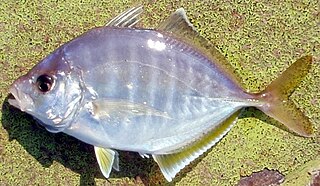 W
WThe whitefin trevally, also known as the horse trevally, is a species of deep water offshore fish in the jack family Carangidae. The species inhabits the tropical to temperate waters of the Indo-Pacific and central Pacific, ranging from South Africa in the west to Hawaii in the east. The whitefin trevally is a moderate-sized fish, growing to 37 cm, and is distinguished by a number of morphological traits, including fin size, gill raker count, and colour. It inhabits the continental shelf and slope at depths to 200 m over sand and mud substrates, where it preys on fish, crustaceans, and cephalopods. Studies in Japan indicate a length at sexual maturity of 17.4 cm on average, with spawning occurring between May and October, with each individual spawning multiple times. Whitefin trevallies are of high importance to fisheries in Japan, where they are taken by trawlers, although the catch numbers have halved since the 1980s. It is of minor importance elsewhere throughout its range, but is considered a good table fish.